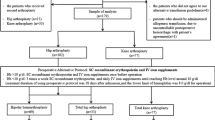Abstract
Introduction
The risk of requiring allogeneic blood transfusion after total knee arthroplasty has been recently decreased with several methods such as blood donation, blood salvage, and hematinic. For patients with a low baseline hemoglobin level, however, the rate of allogeneic transfusion is still high, and an effective method for avoiding allogeneic blood transfusion has not been established. We introduced intra- and postoperative blood salvage with the Cell Saver for patients with a baseline hemoglobin level lower than 130 g/l and analyzed the frequency of allogeneic blood transfusion.
Materials and methods
From 1993 to 1997, 218 consecutive total knee arthroplasties were performed, and 155 knees with baseline hemoglobin lower than 130 g/l were included in this study. Baseline hemoglobin ranged from 62 to 129 g/l, with a mean of 110 g/l. All patients were managed with intra- and postoperative blood salvage with the Cell Saver. Preoperative autologous blood donation and/or use of hematinic was performed for 129 knees (group 1) and was not performed for 26 knees (group 2). There were no significant differences between the two groups with regard to preoperative factors. To examine the role of perioperative factors (age, sex, baseline hemoglobin level, revision procedure, preoperative blood donation, and use of hematinic) in determining the requirements for allogeneic transfusion, backward elimination logistic regression analysis was used.
Results
Seven knees (4.5%) required allogeneic transfusion. Group 1 (2.3%) exhibited a lower rate of allogeneic blood transfusion than group 2 (15.4%) (p=0.016). Hemoglobin levels on the day (p=0.016), 1 week (p=0.0001), and 2 weeks (p=0.007) after surgery were lower in group 1 than in group 2. Backward elimination logistic regression analysis showed that preoperative blood donation (p=0.048) and use of hematinic (p=0.040) were significantly associated with a requirement for allogeneic blood transfusion.
Conclusion
Preoperative blood donation and use of hematinic were associated with a low incidence of allogeneic blood transfusion after total knee arthloplasty with intra- and postoperative blood salvage, even for patients with a baseline hemoglobin level below 130 g/l.
Similar content being viewed by others
References
Adalberth G, Bystrom S, Kolstad K, Mallmin H, Milbrink J (1998) Postoperative drainage of knee arthroplasty is not necessary: a randomized study of 90 patients. Acta Orthop Scand 69:475–478
Berman AT, Geissele AE, Bosacco SJ (1988) Blood loss with total knee arthroplasty. Clin Orthop 234:137–138
Bierbaum BE, Callaghan JJ, Galante JO, Rubash HE, Tooms RE, Welch RB (1999) An analysis of blood management in patients having a total hip or knee arthroplasty. J Bone Joint Surg Am 81:2–10
Billote DB, Glisson SN, Green D, Wixson RL (2002) A prospective, randomized study of preoperative autologous donation for hip replacement surgery. J Bone Joint Surg Am 84:299–304
Burkart BC, Bourne RB, Rorabeck CH, Kirk PG, Nott L (1994) The efficacy of tourniquet release in blood conservation after total knee arthroplasty. Clin Orthop 299:147–152
Cushner FD, Friedman RJ (1991) Blood loss in total knee arthroplasty. Clin Orthop 269:98–101
Faris PM, Ritter MA, Abels RI (1996) The effects of recombinant human erythropoietin on perioperative transfusion requirements in patients having a major orthopaedic operation. The American Erythropoietin Study Group. J Bone Joint Surg Am 78:62–72
Fiebig E (1998) Safety of the blood supply. Clin Orthop 357:6–18
Friederichs MG, Mariani EM, Bourne MH (2002) Perioperative blood salvage as an alternative to predonating blood for primary total knee and hip arthroplasty. J Arthroplasty 17:298–303
Hatzidakis AM, Mendlick RM, McKillip T, Reddy RL, Garvin KL (2000) Preoperative autologous donation for total joint arthroplasty. An analysis of risk factors for allogenic transfusion. J Bone Joint Surg Am 82:89–100
Keating EM, Meding JB, Faris PM, Ritter MA (1998) Predictors of transfusion risk in elective knee surgery. Clin Orthop 357:50–59
Lemons MJ, Healy WL (1996) Blood transfusion in orthopaedic operations. J Bone Joint Surg Am 78:1260–1270
Lotke PA, Faralli VJ, Orenstein EM, Ecker ML (1991) Blood loss after total knee replacement. Effects of tourniquet release and continuous passive motion. J Bone Joint Surg Am 73:1037–1040
Mauerhan DR, Nussman D, Mokris JG, Beaver WB (1993) Effect of postoperative reinfusion systems on hemoglobin levels in primary total hip and total knee arthroplasties. A prospective randomized study. J Arthroplasty 8:523–527
Mylod AG Jr, France MP, Muser DE, Parsons JR (1990) Perioperative blood loss associated with total knee arthroplasty. A comparison of procedures performed with and without cementing. J Bone Joint Surg Am 72:1010–1012
Sakawa A, Tada K, Minoda Y, Nakagawa S, Azuma B (1998) Autologous blood transfusion in implant arthroplastiy in rheumatoid arthritis. Orthop Surg 34:95–98
Salido JA, Marin LA, Gomez LA, Zorrilla P, Martinez C (2002) Preoperative hemoglobin levels and the need for transfusion after prosthetic hip and knee surgery: analysis of predictive factors. J Bone Joint Surg Am 84:216–210
Stowell CP, Chandler H, Jové M, Guilfoyle M, Wacholtz MC (1999) An open-label, randomized study to compare the safety and efficacy of perioperative epoetin alpha with preoperative autologous blood donation in total joint arthroplasty. Orthopedics 22 [Suppl 1]:S105–112
Author information
Authors and Affiliations
Corresponding author
Rights and permissions
About this article
Cite this article
Minoda, Y., Sakawa, A., Fukuoka, S. et al. Blood management for patients with hemoglobin level lower than 130 g/l in total knee arthroplasty. Arch Orthop Trauma Surg 124, 317–319 (2004). https://doi.org/10.1007/s00402-004-0647-8
Received:
Published:
Issue Date:
DOI: https://doi.org/10.1007/s00402-004-0647-8




